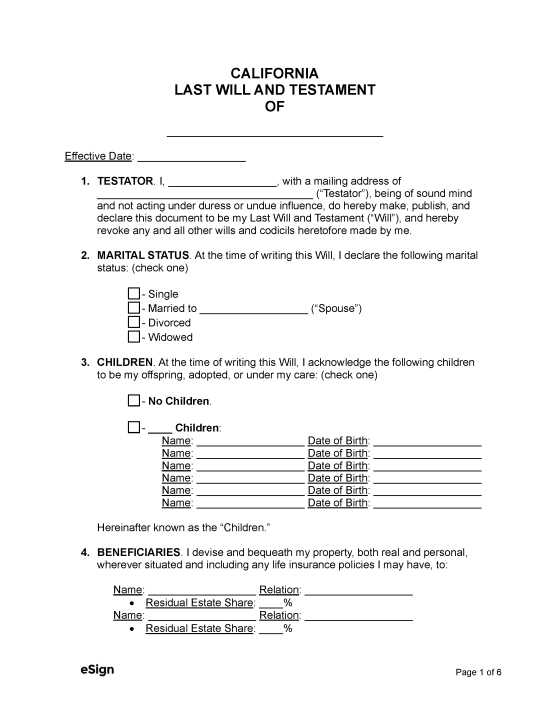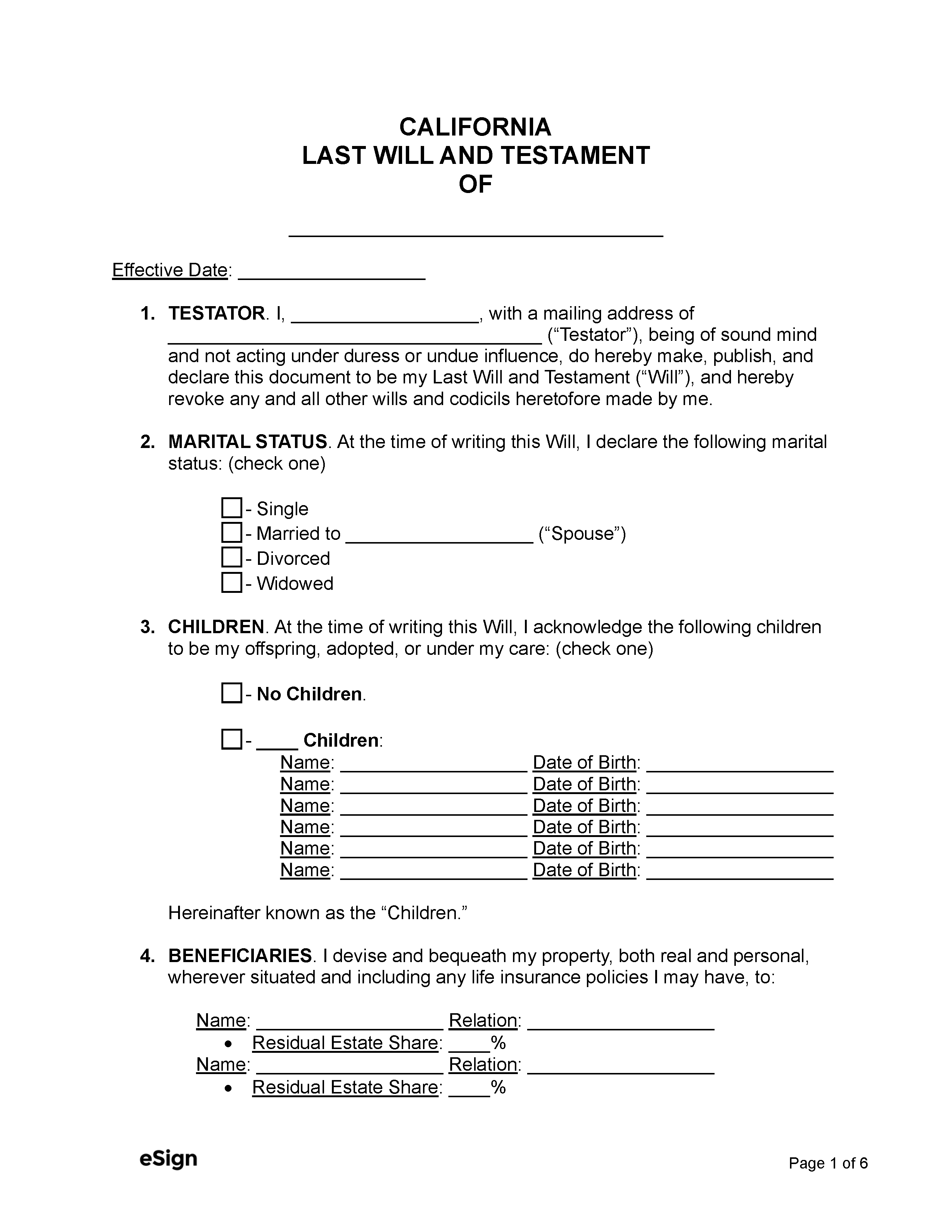State Laws
Any individual 18 years of age or older can make a will if they have the capacity to do so.[1]
Holographic Wills – If the following conditions are met, a handwritten will is valid even if there are no witnesses:[2]
- The signature and all provisions are in the handwriting of the person making the will.
- The person making the will has “testamentary capacity” at the time of its execution.
- The will is dated (required in most cases).
Revocation – A will or any provision can be revoked by a subsequent will or by being physically destroyed.[3]
Any spousal distributions are revoked after the dissolution, annulment, or termination of a marriage.[4], [5]
Signing Requirements – A will must be signed with at least two subscribing witnesses.[6]
Probate Process in California (8 steps)
After a person dies in California, the individual in charge of their will has 30 days to submit it to the clerk of the superior court in their county and send a copy to the executor named in the will. The copy can be sent to a named beneficiary if the will doesn’t name an executor.[7]
If an executor is named in the will, they are required to file a petition to begin probate within 30 days of discovering the decedent’s death to avoid losing their appointment.[8]
- Petition for Probate
- Notices
- Court Hearing
- Letters Testamentary & Bond
- Inventory of Assets
- Claims & Objections
- Selling Assets (If Applicable)
- Payment of Debts & Taxes
- Closing
The following is meant to be a general overview of the probate process. It is recommended that executors/personal representatives consult with an attorney if they’re unsure of any step.
1. Petition for Probate
If an estate’s probate assets are valued at $166,250 or less and don’t include real property, the court process may be avoided.[11] To distribute an estate that qualifies for the simplified process, a successor must complete an Affidavit for Collection of Personal Property and file the required forms with the superior court.
To begin the probate of a will, a Petition for Probate must be filed with the superior court in the county where the decedent was a resident.[9] The superior court will set an initial hearing date between 15 and 30 days from when the petition was filed.[10]
2. Notices
After a Petition for Probate has been filed and a hearing date is set, the superior court or the person who filed the petition will arrange for the publication of a Notice of Petition to Administer Estate in a local newspaper.[13] Publication must occur at least three times, with five days between each publication. Notices must also be sent to all named beneficiaries and legal heirs at least 15 days before the hearing date. If the petitioner isn’t the executor, the executor must be sent notice as well.[14]
Interested parties may file a Request for Special Notice that allows them to receive copies of any paperwork filed by the representative.
3. Court Hearing
On the hearing date, the superior court will appoint the executor and determine if the will is valid. If no executor is named in the will, the court will appoint an administrator to act as the estate’s representative. If everything is in order, the court will execute an Order for Probate to admit the will to probate.
4. Letters Testamentary & Bond
After the representative has been appointed, they must file the below forms to request Letters Testamentary (if an executor) or Letters of Administration (if an administrator). These letters will complete their appointment as personal representative.
The letters give the personal representative authority to oversee the estate, including controlling assets, paying the decedent’s debts and taxes, selling assets, and distributing assets to beneficiaries.[15]
The court often requires the representative to secure and file a bond to insure the estate for an amount equal to its value.[16] The representative doesn’t need a bond if the will, beneficiaries, or heirs waive the requirement (Form DE-142).[17]
5. Inventory of Assets
One of the representative’s main responsibilities is to take inventory and possession of all the decedent’s assets that are subject to probate. All debts, securities, partnership interests, money, and cash items must also be included.[18] A probate referee will usually need to establish the value of all non-cash assets before the representative completes and files the Inventory and Appraisal form (Form DE-160) for court approval.[19]
6. Claims & Objections
The executor or administrator is required to send a Notice of Administration to Creditors to the decedent’s known creditors.[20]
Creditors are given four months from the Order for Probate to file claims against the estate for the decedent’s debts. Each claim will either be accepted or rejected by the representative through the filing of Form DE-174. The representative will pay any valid claims from the decedent’s estate.
A will may be contested by any interested party that files an objection with the superior court. After filing, a summons and copy of the objection will be served on the heirs and devisees, who must respond within 30 days.[21]
7. Selling Assets (If Applicable)
The representative may need to sell estate assets to pay debts and taxes. The representative can sell any estate property if the interested beneficiaries don’t object after being given 15 days’ notice. In some cases, the personal representative will need to obtain court approval before any sale. They may also sell the decedent’s property during probate if directed to by the beneficiaries.
8. Payment of Debts & Taxes
The representative may be liable for any taxes and debts not paid before closing probate.[23]
9. Distribution & Closing
Once the above steps have been completed, the representative will file a Final Account, Final Report, and a Petition for Distribution. If the beneficiaries have signed and filed a Waiver of Account (SAMPLE), the final account doesn’t need to be filed.
- Form PR-165 (SAMPLE) – First and Final Report of Personal Representative & Petition for Final Distribution can be used for the filing of the representative’s final report and petition.
If a federal estate tax return is required, the petition must be filed within 18 months after Letters Testamentary were issued (one year if no federal return was required).[24] Upon the petition’s approval, the representative can oversee the distribution of any remaining assets to the beneficiaries as directed by the will.
After distribution, the representative will file a Petition for Final Discharge and Order to close the probate. If a federal estate tax return is required, the petition must be filed within 18 months after Letters Testamentary were issued (one year if no federal return was required).[24] The petition will include an accounting of the representative’s actions regarding the estate and any fees they were paid. After the petition’s approval, probate will be closed and the representative’s duties will be completed.[25]

